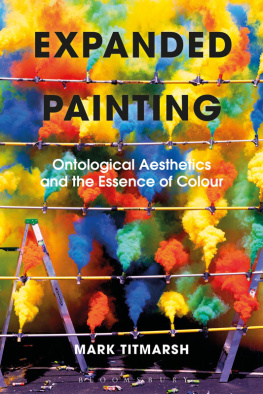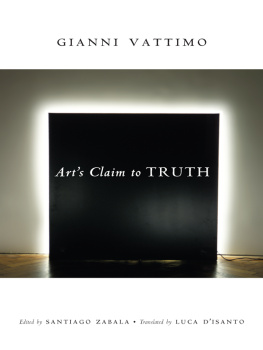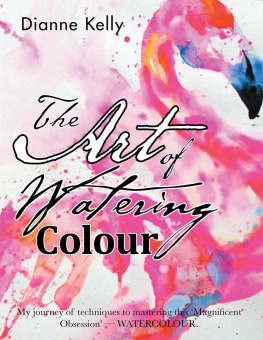Titmarsh - Expanded painting ontological aesthetics and the essence of colour
Here you can read online Titmarsh - Expanded painting ontological aesthetics and the essence of colour full text of the book (entire story) in english for free. Download pdf and epub, get meaning, cover and reviews about this ebook. City: London, year: 2019, publisher: Bloomsbury UK;Bloomsbury Academic, genre: Art. Description of the work, (preface) as well as reviews are available. Best literature library LitArk.com created for fans of good reading and offers a wide selection of genres:
Romance novel
Science fiction
Adventure
Detective
Science
History
Home and family
Prose
Art
Politics
Computer
Non-fiction
Religion
Business
Children
Humor
Choose a favorite category and find really read worthwhile books. Enjoy immersion in the world of imagination, feel the emotions of the characters or learn something new for yourself, make an fascinating discovery.
Expanded painting ontological aesthetics and the essence of colour: summary, description and annotation
We offer to read an annotation, description, summary or preface (depends on what the author of the book "Expanded painting ontological aesthetics and the essence of colour" wrote himself). If you haven't found the necessary information about the book — write in the comments, we will try to find it.
Titmarsh: author's other books
Who wrote Expanded painting ontological aesthetics and the essence of colour? Find out the surname, the name of the author of the book and a list of all author's works by series.
Expanded painting ontological aesthetics and the essence of colour — read online for free the complete book (whole text) full work
Below is the text of the book, divided by pages. System saving the place of the last page read, allows you to conveniently read the book "Expanded painting ontological aesthetics and the essence of colour" online for free, without having to search again every time where you left off. Put a bookmark, and you can go to the page where you finished reading at any time.
Font size:
Interval:
Bookmark:
Expanded Painting
Also available from Bloomsbury
Endless Andness, Mieke Bal
Thinking in Film, Mieke Bal
Reparative Aesthetics, Susan Best
Making Sense, Lorna Collins
Aesthetics and Painting, Jason Gaiger
The Bloomsbury Anthology of Aesthetics, edited by Joseph J. Tanke and Colin McQuillan
The Curatorial, edited by Jean-Paul Martinon
Expanded Painting
Ontological Aesthetics
and the Essence of Colour
Mark Titmarsh
Bloomsbury Academic
An imprint of Bloomsbury Publishing Plc

For Cameron Tonkinwise, the university of one
Special thanks to Andrew Benjamin and Kees Dorst, who helped shape the text, and the Faculty of Design, Architecture and Building, The University of Technology Sydney, Australia, whose generous support made the whole project possible.
If one uses paint to make art, then it is first of all paint before it can be realised in its intended state, that is, as art
Ian Burn
Painting?
This book is a map of painting and the questions that confront its ongoing status in the professional domain of contemporary art. It involves searching the full spectrum of painting, from the processes that take place in the artists studio right through to the intellectual arguments that position and justify certain disciplines and genres of painting above others. Painting is a major art form that has been both rejected and revered. It is often rejected as an out-dated tradition very long in the tooth, 40,000 years if we go back to Lascaux and the rock paintings of the original Australians. Surely something so old is irrelevant by now, lost in the stories of its own past, tangled up in conventions that are like old coins, details worn away, but still shopped around as common currency. On the other hand painting is revered because so many still practice it, passionate students arriving at art school, art markets dealing in new and old masters, galleries selling painted canvases for appreciation, investment and decoration.
Painting, together with Sculpture and Architecture, forms an original triad of classical arts dating back to ancient Greece. Since that time painting has been the dominant art form, with an ability to say anything about everything, including self and world, politics and literature, science and popular culture. All of it is done in the hushed silence of colour on an immobilized surface.
Over the last 100 years the position of painting has been questioned and vanquished many times, in particular by photography and new media. Yet somehow it lives on, commanding our respect like an immortal warrior or at least some kind of urban zombie. It has become a hybrid of the living and the dead, something contemporary and something remembered, involving the use of craft materials that can plug into electronic media, sculptural objects, performative events and theoretical texts. All of these elements form a new kind of contemporary practice for painting that struggles for a proper name.
As a result painting in the twenty-first century is understood as a visual phenomenon that can be physically extended and challenged by non-visual practices. This was originally initiated by Conceptual Art in 1960s with an attempt to get beyond the eye, to include other sensory modes and in particular the critical power of thinking in relation to art making. The eye was seen as a political prejudice that somehow denigrated the other senses and forced work up against the wall, so that it could be captured as a commodity for a fully self-sufficient viewer. Conceptual Painting dematerialized the painted image in favour of ideas, constructions, processes and ephemeral events. This completed the synthesis of a physical/pictorial dialectic begun in Cubism, where painting was, for the first time, treated as something more than an infinitely thin surface on which illusory depths could be projected. The movement from Cubism to Conceptual art constituted an historical drive to dismantle painting and reconstruct it in the context of new regimes of vision brought on by media revolutions of the twentieth century that included photography, cinema and television. Since then new digital media and the related concepts of information space have forced another rethinking of the camera obscura model of perspectival vision towards a decentred multi-layered quantum of sensory experience.
An ecology of painting?
The freedom of painting to move beyond a flat picture plane is more than a conceptual argument about vision. Understanding the broader context of painting involves a movement outward through the formal technologies of the craft to a global cultural environment as well as a journey inwards through conceptual schemas to formal trends in contemporary art making. To be able to move in both directions at once involves a different intellectual schema ). Consequently, ecological thinking could become an all-encompassing lens through which everything including painting could be seen and understood.
as well as a new model for discussing art in its elemental status.
Heidegger also focuses on inter relationships as opposed to isolated individuals and objects in his discussion of tools and their usage. He argues that the tool disappears into the empire of equipment and at the same time the user and the tool become part of a process of making where there is no division between the person, the tool and the process. From an ecological perspective the same field dynamic occurs in a natural setting where each element such as animal, earth, sun, air and water play an indivisible part in the life of an ecosystem. Neither tool nor ecosystem is thought about in the daily rounds of life until they break down and need some kind of repair, as we find in our current state of global warming.
Fieldworks
The problem with ecological models applied to art is that they are framed in relation to biology and the natural sciences and tend to exclude more subtle methods for the consideration of contemporary art. The precise language and mathematical constructs of science-based ecology leaves little room for the imprecise non-functionality of art.
What can be borrowed from ecology is the model of a general field dynamic, already familiar to practitioners of structural analysis in literature and the visual arts. Consistent with this, Rosalind Krauss used a field model, borrowed from structural linguistics, to study avant-garde developments in contemporary art. Her writings on the expanded field became the basis of a postmodern understanding of art in relation to both sculpture and painting. She also provides the link for building a line of enquiry that grows out of scientific mathematical thinking into a more specific yet flexible discourse for art.
Consequently, this book builds towards a philosophy of art with a particular focus on painting, as opposed to a science of art by way of ecology and structuralism. From such a position the primary questions become: What is painting? How is painting ordinarily understood? What do unusual non-traditional forms of painting tell us about the boundaries of painting? What do boundaries and limits tell about essences and the core of painting? And finally what is the being of painting?
The nature of painting is something that is rarely discussed in a deeper philosophical sense. Much discussion of contemporary painting focuses on the death of painting, the end of a conservative and ossified discipline now superseded by contemporary forms such as installation art and digital media. Other discussions of contemporary painting focus on the content of painting, its figuration or abstraction, its political nature, its topicality, references to is still obscured.
Next pageFont size:
Interval:
Bookmark:
Similar books «Expanded painting ontological aesthetics and the essence of colour»
Look at similar books to Expanded painting ontological aesthetics and the essence of colour. We have selected literature similar in name and meaning in the hope of providing readers with more options to find new, interesting, not yet read works.
Discussion, reviews of the book Expanded painting ontological aesthetics and the essence of colour and just readers' own opinions. Leave your comments, write what you think about the work, its meaning or the main characters. Specify what exactly you liked and what you didn't like, and why you think so.













